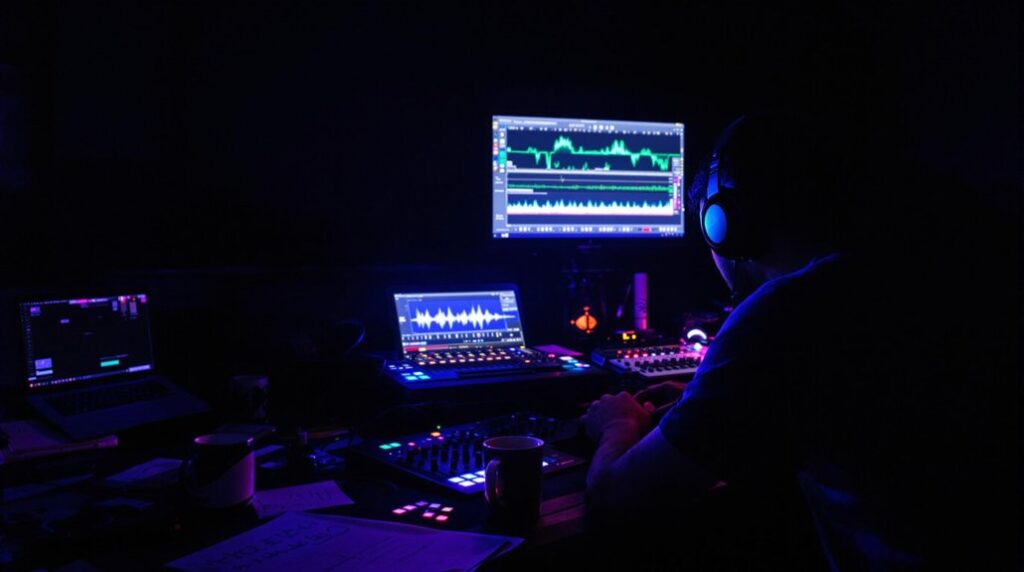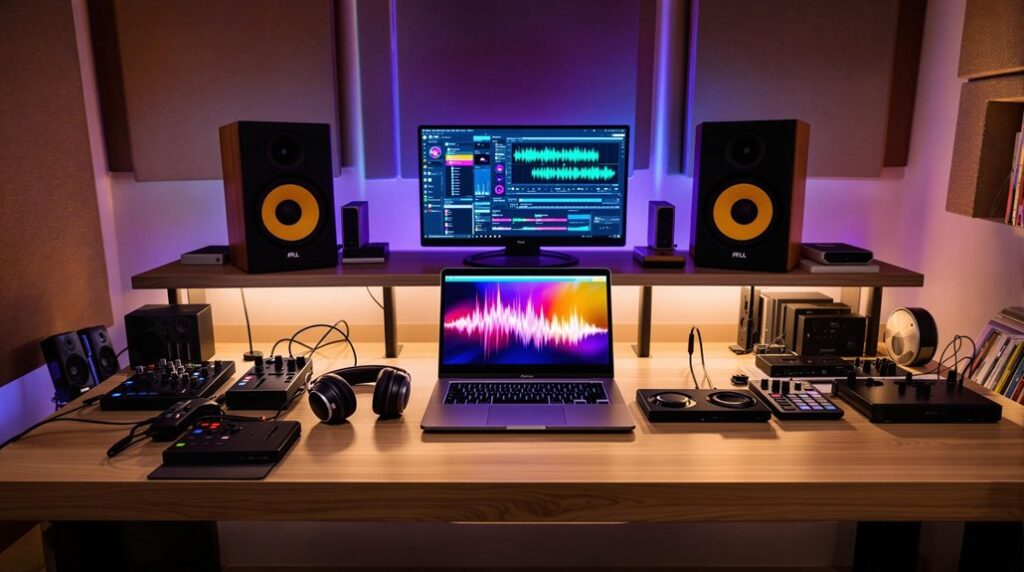In audio mixing, you’ll use compression to manage dynamic range and enhance sound clarity. By adjusting the threshold and ratio, you control when compression kicks in and its intensity. Fine-tuning attack and release times affects transient response and rhythmic flow. Techniques like parallel and multiband compression offer creative control over your mix. A well-compressed track maintains consistent volume, prevents clipping, and brings out the nuanced details of your music, making it sound polished and professional. Explore further to understand how this essential tool can transform your mixes.
Key Takeaways
- Compression controls the dynamic range, ensuring consistent volume levels across the mix.
- It enhances clarity and presence by managing peaks and transients effectively.
- Compression adds warmth and cohesion, making instruments and vocals blend seamlessly.
- It prevents clipping and distortion, maintaining a clean and professional sound.
- Proper compression techniques can emphasize important elements, making a mix sound powerful and immersive.
Understanding Audio Compression
Mastering the basics of audio compression is crucial for effectively managing the dynamic range and enhancing the overall sound quality of your mix. Compression operates by reducing signal levels that surpass a designated threshold, enabling you to manage the dynamic range of your audio. It’s not about making sounds louder; it’s about controlling dynamics and elevating presence.
When delving into compression fundamentals, you should be mindful of its advanced techniques. Adjusting parameters like threshold, ratio, attack, release, knee, and make-up gain allows you to finely adjust how the compressor impacts your signal. For instance, establishing a lower threshold and a higher ratio will lead to more pronounced gain reduction, while tweaking the attack and release times can shape the envelope of your sound for a more organic or impactful effect.
Compression uses go beyond simply managing dynamics. You can employ innovative compression techniques to introduce warmth, unite tracks seamlessly, or highlight subtle nuances. For instance, parallel compression enables you to blend a heavily compressed signal with the original for added depth without compromising dynamics.
Familiarizing yourself with these advanced techniques and applications ensures that your mixes are well-balanced, coherent, and expertly refined.
Key Compression Parameters
To master audio compression, you must explore the pivotal parameters like threshold, ratio, attack, and release, each of which plays an essential role in shaping your mix’s dynamics. These compression techniques form the backbone of dynamic control, enabling you to craft professional and polished audio outputs.
The threshold sets the level at which compression begins, determining how much of the signal is processed. It’s vital for defining when the compressor engages.
The ratio controls the amount of gain reduction applied once the signal surpasses the threshold, influencing the intensity of compression. Balancing these two parameters is a key part of effective mixing strategies.
Attack time dictates how quickly the compressor reacts to the input signal. A fast attack can tame sharp transients, while a slower attack allows more of the initial sound to pass through, preserving its natural punch.
Release time governs how long the compressor takes to disengage after the signal falls below the threshold. A shorter release can help retain a track’s energy, whereas a longer release smoothens out the overall dynamics.
Understanding these key parameters and adjusting them precisely is essential for achieving the desired audio outcomes. Use these mastering tips to refine your mixing process and achieve superior dynamic control.
Threshold and Ratio Explained
When you set the threshold in a compressor, you’re determining the point at which the device starts to reduce gain, thereby impacting how much of the signal is compressed.
The ratio setting, on the other hand, specifies the degree of compression applied to the audio signal once it surpasses the threshold.
Understanding and balancing these parameters is essential for effectively controlling the dynamics and achieving the desired compression effect.
Defining Threshold in Compression
In audio mixing, the threshold in compression dictates the specific signal level at which the compressor starts to attenuate the audio, directly influencing the overall dynamic range. By setting the threshold, you determine the point at which the compressor begins to reduce the gain of the incoming signal. This is important for controlling the dynamics of the audio track.
Threshold manipulation allows you to fine-tune how much of your audio signal gets compressed. Lowering the threshold makes the compressor respond to a broader range of the signal, including quieter parts. Conversely, a higher threshold restricts compression to only the louder segments. Mastering these compression thresholding techniques can greatly enhance your mix’s clarity and balance.
To effectively set the threshold, consider the following steps:
- Identify the loudest peaks: Use a peak meter to find the highest levels of your track.
- Set the initial threshold: Start by setting the threshold just below these peaks.
- Listen and adjust: Play the track and adjust the threshold to achieve the desired dynamic control without over-compressing.
- Fine-tune with ratio: Once the threshold is set, adjust the ratio to balance between preserving dynamics and achieving smooth compression.
Optimal Ratio Settings
After setting your threshold, you’ll need to focus on the ratio to determine how aggressively the compressor will reduce the gain above that threshold. In audio mixing, the ratio selection is vital as it dictates the extent of compression applied once the signal crosses the threshold.
Lower ratios, such as 2:1, offer subtle compression, preserving much of the original dynamics. These settings are useful for maintaining musicality while gently controlling levels.
On the other hand, higher ratios, like 8:1 or more, deliver more aggressive compression, greatly reducing gain and creating a more controlled, sometimes even squashed sound. This can be beneficial for certain genres or artistic choices where a tight, polished sound is desired.
To achieve the best ratio setting, you’ll need to balance the desired compression intensity with the natural musical dynamics of the audio. This involves adjusting both the threshold and ratio settings in conjunction, allowing for precise control over the compression amount and its impact on the mix.
Mastering these compression techniques is essential for achieving your artistic vision while ensuring the audio remains dynamic and engaging. Understanding how threshold and ratio interact will help you achieve the perfect compression effect.
Balancing Dynamics Effectively
To balance dynamics effectively in audio mixing, you must precisely adjust both the threshold and ratio settings to guarantee a controlled and cohesive mix. The threshold sets the level at which the compressor begins to reduce gain, while the ratio determines the extent of that gain reduction. Proper adjustment of these parameters is essential for achieving level consistency and managing the dynamic range of your audio tracks.
Here’s how to do it:
- Set the Threshold: Start by setting the threshold just below the peak levels of your audio signal. This ensures that compression kicks in only when necessary, maintaining the signal’s natural dynamics.
- Adjust the Ratio: Choose a ratio that aligns with the desired level of compression. A low ratio (e.g., 2:1) offers subtle control, while a high ratio (e.g., 8:1) provides aggressive compression.
- Monitor the Gain Reduction: Keep an eye on the gain reduction meter to make sure you’re not over-compressing, which can squash the dynamic range and lead to a lifeless mix.
- Fine-Tune Both Settings: Continuously tweak the threshold and ratio settings while listening critically to maintain a natural sound and consistent levels.
Understanding and managing these settings will help you achieve a balanced dynamic range and professional level consistency in your mixes.
Attack and Release Settings
To optimize your compression, start by setting the attack time to control how quickly the compressor responds to the input signal, which affects the sharpness of transients.
Next, adjust the release duration to determine how long the compressor holds onto the signal, impacting the naturalness and sustain.
Balancing these settings is key to achieving the desired punch and rhythmic flow in your mix.
Optimizing Attack Time
Mastering the attack time settings on your compressor is essential for shaping the initial transients and enhancing the overall clarity of your mix. Proper attack settings allow you to achieve transient preservation while maintaining dynamic control.
Here’s how to optimize attack time effectively:
- Transient Preservation: Setting a slower attack time helps preserve the initial transient of a sound, which is vital for retaining the natural attack of percussive elements. This guarantees that drums and other sharp sounds maintain their percussive clarity and contribute to the mix punch.
- Dynamic Control: Faster attack times are useful for controlling peaks and smoothing out dynamic fluctuations. This approach is ideal when you need to tame overly aggressive transients without losing too much of the initial impact.
- Balancing Act: Experiment with different attack times to find the right balance between transient preservation and dynamic control. This can vary depending on the instrument and the overall context of the mix.
- Musical Compression: Aim for a natural-sounding compression by fine-tuning the attack settings. This helps in achieving a musical and cohesive mix where each element sits well together without sounding overly compressed.
Adjusting Release Duration
After fine-tuning the attack time, attention must shift to adjusting the release duration to ensure a cohesive and natural-sounding compression effect. The release duration determines how quickly the compressor ceases to affect the audio signal once the input level falls below the threshold. This control is essential for maintaining the overall dynamics and musicality of your mix.
Understanding the release timing nuances is important. A fast release can cause the compressor to recover quickly after audio peaks, adding punch and clarity, but may introduce unnatural artifacts if not managed well.
Conversely, a longer release time can smooth out the compression effect, resulting in a more natural sound that can enhance the musicality of the track.
The release duration impact extends beyond just the technical aspects; it also allows you to exercise creativity. Properly adjusted release parameters help shape the rhythmic flow and feel of the music, ensuring that the compression effect remains musical and balanced.
This nuanced control, in conjunction with other parameters like attack, provides the necessary level of transparency and control over the audio dynamics, enhancing the overall quality of the mix without causing distortion.
Benefits of Using Compression
Compression provides precise control over the dynamic range of your audio, ensuring that peaks are tamed and quieter sections are brought forward for a more balanced and polished mix. By giving you the ability to manage dynamic control, compression opens up a world of creative applications. It allows you to shape the tonal characteristics of your tracks, enhancing the musical impact of your mix.
Here are some key benefits of using compression:
- Dynamic Control: It helps to smooth out the volume levels, ensuring that no part of the audio is too loud or too quiet. This creates a more consistent listening experience.
- Tonal Shaping: Compression can add punch and presence to instruments and vocals, making them stand out in the mix. This tonal shaping is essential for achieving a professional sound.
- Mix Cohesion: By gluing different elements together, compression can make your mix sound more unified and coherent. This is vital for creating a polished final product.
- Enhanced Clarity and Balance: Properly applied compression can bring forward important elements of your track, improving overall clarity and balance, and making it easier for listeners to engage with your music.
Using compression wisely is key to achieving a professional and impactful mix.
Common Compression Techniques
Several common compression techniques can greatly enhance your audio mixing process by providing precise control over different aspects of your track’s dynamics. One effective technique is parallel compression, also known as New York compression. It involves blending a heavily compressed signal with the original, giving your mix added punch and clarity without sacrificing natural dynamics.
Another advanced method is serial compression, where you apply multiple compressors in succession. This allows for meticulous control over the dynamics, fine-tuning the attack and release characteristics at various stages.
Sidechain compression is another versatile tool. By using a separate input to trigger compression on a different track, you can achieve the iconic pumping effect often heard in EDM, making it a valuable asset for creative uses.
Multiband compression divides your audio signal into frequency bands, enabling targeted compression adjustments. This technique is particularly useful for managing complex mixes with varying frequency content.
Here’s a quick reference table to highlight these techniques:
| Technique | Description |
|---|---|
| Parallel Compression | Blends heavily compressed signal with original for dynamic mix |
| Serial Compression | Applies multiple compressors successively for precise control |
| Sidechain Compression | Uses separate input to trigger compression on a different track |
| Multiband Compression | Divides audio into frequency bands for targeted adjustments |
Avoiding Compression Mistakes
Frequently, engineers make the mistake of setting the compressor threshold too low, resulting in excessive and unnatural compression that can detract from the mix’s overall quality. This issue can lead to compression artifacts, which manifest as pumping or breathing effects, disrupting the mix’s natural flow. To avoid these pitfalls, make subtle adjustments and pay close attention to the dynamic range of your tracks.
Here are key points to keep in mind:
- Set Appropriate Thresholds: Avoid setting the threshold too low to prevent over-compression. This preserves the track’s natural dynamics and avoids a flat, lifeless sound.
- Attack and Release Times: Be cautious with fast attack times, especially on drums. Fast attacks can squash transients, impacting the natural feel and energy of the sound.
- Moderate Compression: Apply compression in moderation. Excessive compression can dull the overall audio quality, making the mix sound unnatural and overly processed.
- Element-Specific Effects: Understand how compression affects different elements of the mix. For instance, vocals and instruments may require different compression settings to maintain clarity and presence.
Enhancing Mix With Compression
Effectively utilizing compression can transform your mix by controlling the dynamic range and adding punch to the overall sound. By compressing individual tracks, you can smooth out performance dynamics, guaranteeing that louder and softer parts blend seamlessly. This technique adds character, especially to percussive elements, giving them a more defined and impactful presence.
One of the creative applications of compression involves crushing room mics. By heavily compressing these mics, you can enhance textures and inject excitement and energy into your mix. This artistic choice can bring a sense of liveliness and space that enhances the musical impact of your recordings.
Sidechain compression is another powerful tool, particularly in genres like EDM. By using a kick drum to trigger compression on other elements, you create a pumping effect that adds rhythmic interest and cohesion. This technique not only enhances the groove but also ensures that key elements like the bass and kick drum don’t clash.
Understanding how to effectively use these compression tools is essential. It allows you to make informed artistic choices that enhance textures and increase the overall musical impact of your mix, resulting in a more polished and professional sound.
Frequently Asked Questions
What Does Compression Do in Mixing?
Compression in mixing reduces the dynamic range, helping you control peaks and balance your audio. It guarantees elements fit cohesively, adding punch and clarity. Proper use enhances your mix’s impact, making it sound professional and polished.
What Does a Compressor Do in an Audio Mixer?
In an audio mixer, a compressor controls the dynamic range. You can use side chaining for ducking effects and parallel compression to retain transients while smoothing levels, ensuring a balanced, professional sound.
Why Is Audio Compression Important?
You need audio compression for effective volume control and managing dynamic range. It guarantees consistent levels, tames peaks, and balances sound, adding clarity and cohesion to your mix. Mastering compression techniques is essential for professional results.
What Is the Application of Audio Compression?
You apply audio compression to uphold broadcast standards and achieve dynamic control. It guarantees consistent volume levels, making the loudest parts quieter and the softest parts louder, enhancing clarity and cohesion in your audio mix.
Conclusion
By mastering compression, you’ll enhance your audio mixing skills greatly. You’ll understand how to set thresholds and ratios properly, fine-tune attack and release settings, and apply compression techniques effectively.
Remember, the key is to improve the mix without over-compressing. Avoid common mistakes and focus on the benefits compression offers. With practice, you’ll seamlessly integrate compression, achieving a polished, professional sound that stands out.
Embrace these techniques to refine and perfect your audio mixes.




